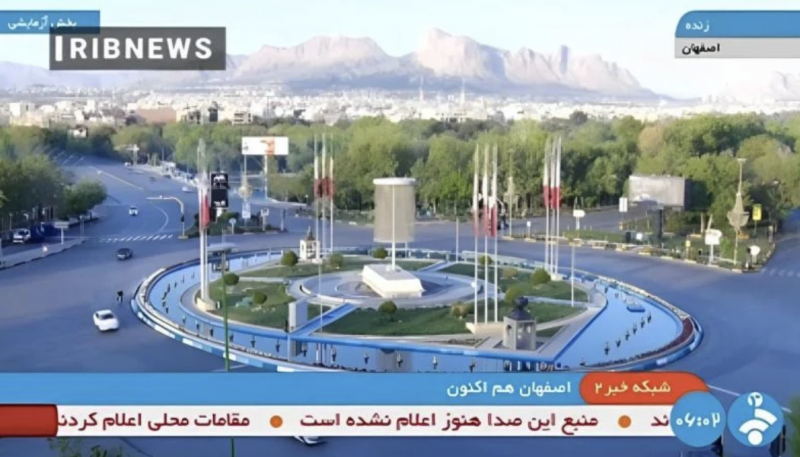
A screenshot from Iranian state television, IRIB, showing the city of Esfahan at peace in the early hours of April 19, 2024 after three explosions were heard in the area. (Credit: AFP/HO/IRIB)
A measured and restrained retaliation was swiftly delivered by Israel less than a week after Iran’s reprisal against it. As Israel’s response unfolded on Thursday night, it prompted speculation: What insights can be gleaned from this Israeli counterattack?
Will it incite a fresh round of Iranian retaliation? L’Orient-Le Jour assessed the situation, offering initial insights into the repercussions of this latest development.
The facts
• According to reports from CBS News, Israel conducted strikes against Iran on Thursday night, as confirmed by two Israeli officials cited in the New York Times (NYT). Additionally, three Iranian officials informed the NYT that the strike targeted a military air base near Isfahan in central Iran.
• Iran activated its air defense systems early on Friday in multiple provinces following reports of explosions in the central region of the country, as stated by the Islamic Republic News Agency (IRNA). Tehran reported three explosions at approximately 4 a.m. local time on Friday near a military base in central Iran, according to the Fars News Agency.
• Iranian authorities reported that while drones were intercepted, there have been no missile attacks thus far. The Iranian Tasnim News Agency reassured that nuclear facilities situated in the Isfahan region remain “completely safe.” Additionally, the IRNA announced that there was “no major damage” resulting from the reported incidents.
• At present, Israeli officials refrained from issuing any statements regarding the recent developments.
• In addition to the reported incidents in Iran, explosions were also noted in southern Syria near a Syrian army radar position, as reported by the Syrian Observatory for Human Rights.
Background
• This Israeli strike appears to have marked the initial retaliation to the Iranian attack that occurred on Saturday night. It signifies a notable departure from Iran’s decades-long strategy. For the first time in its history, Iran directly targeted Israel, breaking from its previous approach.
• Israel promised a “significant and imminent” retaliation following the Iranian attack. However, under mounting international pressure (notably from the United States), Tel Aviv appears to have chosen a restrained and carefully measured operation.
• Iranian officials issued immediate threats of retaliation in response to any new Israeli attack.
• In recent days, Hezbollah has conducted precision strikes targeting northern Israel, seemingly to convey a clear message: Should tensions escalate, Iran will not stand alone. Warning sirens sounded in northern Israel shortly after the strike, underscoring the heightened tensions in the region.
• Throughout the week, the US has applied considerable pressure on its Israeli ally, urging restraint to prevent actions that could escalate into a regional conflict.
• Washington requested Israel to coordinate its response. On Tuesday, US officials were informed that an operation would occur within 24 to 48 hours, with no impact on Iran’s nuclear facilities. However, the White House did not endorse Israel’s response, as indicated by an official quoted by CNN.
The stakes
• Israel has reportedly received support and coordination from various Western and Arab nations to safeguard itself against the Iranian attack. However, such coordination could have been significantly undermined by a large-scale Israeli assault on Iran.
• It appears that Israel aimed to demonstrate its capacity to conduct a strike on Iranian soil, while endeavoring to mitigate any retaliatory response from Tehran, notably by refraining from targeting nuclear installations.
• Israel’s approach appears to differ from that of Iran, characterized by elements of surprise, limited damage and discretion. This approach could allow both sides to preserve their reputations and prevent a significant escalation. Iran reopened its airspace on Friday morning, downplaying the magnitude of the strikes. However, a source close to Iran’s Islamic Revolutionary Guards Corps (IRGC), speaking to the Mehr News Agency, revealed that the explosions resulted from the interception of three drones by Iranian defense systems.
• This strike is emblematic of the ongoing shadow war between the two nations, as evidenced by the absence of any claims of responsibility.
• Several unanswered questions linger presently: What precisely was the Israeli objective with this strike, and has it been accomplished? Moreover, what prompted this action in the first place, and what are its underlying motivations?
This article was originally published in L'Orient-Le Jour. Translated by Sahar Ghoussoub.